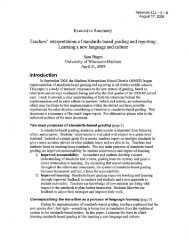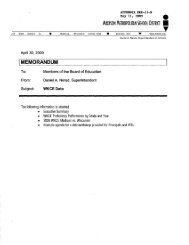Madison Preparatory Academy - School Information System
Madison Preparatory Academy - School Information System
Madison Preparatory Academy - School Information System
You also want an ePaper? Increase the reach of your titles
YUMPU automatically turns print PDFs into web optimized ePapers that Google loves.
Both the state of Wisconsin and the <strong>Madison</strong> Metropolitan <strong>School</strong> District have defined closing the<br />
achievement gap as an “important governmental objective”, and therefore <strong>Madison</strong> Prep’s mission and<br />
purpose is consistent with this. In August 1997, the Wisconsin Department of Public Instruction hired<br />
current Urban League President & CEO Kaleem Caire to establish the Department’s Minority Student<br />
Achievement Initiative, with the aim of addressing the state’s racial and ethnic academic achievement<br />
gaps. On June 30, 2003, Wisconsin State Superintendent of Public Instruction released a press release<br />
stating that “Wisconsin Must Close the Achievement Gap.” 32 In 2008, the Wisconsin Department of<br />
Public Instruction applied to participate in the Federal Race to the Top grant competition, and stated that<br />
one of the state’s primary goals was eliminating the achievement gap. While DPI does not currently list<br />
closing the achievement gap as one of its primary goals or objectives, it does state the following in the<br />
Question & Answers for Race to the Top that it prepared and published on May 14, 2010:<br />
The Race to the Top program is a $4.3 billion fund created under the American Recovery<br />
and Reinvestment Act of 2009. Of this amount, $700 million has already been allocated.<br />
The purpose of Race to the Top is to provide incentives to states to implement largescale,<br />
system-changing reforms that result in improved student achievement, narrowed<br />
achievement gaps, and increased high school graduation and college enrollment rates<br />
(USDE, 2009).<br />
Specifically, in their state RTT application’s introductory letter addressed to the U.S. Secretary of<br />
Education, Arne Duncan on May 27, 2010, Governor Jim Doyle and State Superintendent of Public<br />
Instruction Anthony Evers identified two of Wisconsin’s goals as “ensuring all students are proficient in<br />
math and reading, drastically cut our achievement gap, drastically reduce the number of high school<br />
dropouts and significantly increase high school graduation rates for at-risk populations and increase the<br />
percentage of students who are college and career ready, and significantly increase growth in college<br />
entrances.” They further state that Wisconsin will place “an emphasis on providing additional supports,<br />
particularly in early childhood and for middle and high school transitions, to ensure that Wisconsin<br />
narrows its achievement gap and raises overall achievement.” 33<br />
<strong>Madison</strong> Prep is being offered first and foremost as a solution to the achievement crisis among students of<br />
color, in particular. <strong>Madison</strong> Prep’s educational program also fulfills important local, state and national<br />
priorities by addressing the need to increase the cultural competence, inter-cultural awareness and<br />
international mindedness of young people who will be required to work, lead, compete and thrive in a<br />
vastly more diverse and increasingly open, competitive and challenged world. Young people who<br />
graduate from <strong>Madison</strong> Prep will be ready for college, ready for work and ready to lead and participate in<br />
a global society. This will benefit <strong>Madison</strong>, Wisconsin and our nation as a whole.<br />
2. The International Baccalaureate (IB) Curriculum<br />
The IB curriculum is divided into three “Programmes”: Primary (ages 3 to 12), Middle Years (ages 11 to 16),<br />
and Diploma (ages 16 to 19). The Middle Years Programme provides a framework of academic challenge and<br />
life skills, achieved through embracing and transcending traditional school subjects. The Diploma Programme<br />
is a demanding two‐year curriculum leading to final examinations and a qualification that is welcomed by<br />
leading universities around the world. Each Programme includes a curriculum and pedagogy, student<br />
assessment appropriate to the age range, professional development for teachers and a process of school<br />
authorization and evaluation.<br />
The MYP and DP are based upon comprehensive research and extensive, wide-ranging experience in schools<br />
around the world. They are bolstered by a rigorous set of achievement standards and provide a framework to<br />
guide coherent content instruction from grade to grade, encouraging steady academic, social and intellectual<br />
progress as students expand their intellectual and social capacities, knowledge and skills. Teachers plan<br />
activities, engage students in learning and assess their progress, and then reformulate the plan according to the<br />
results.<br />
33 | P age



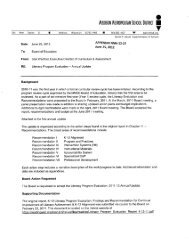
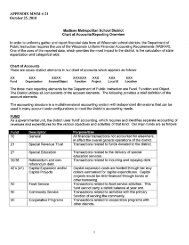
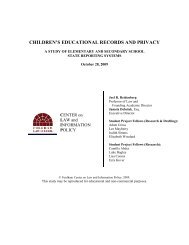

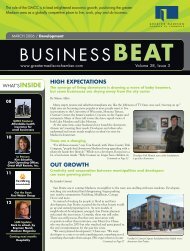
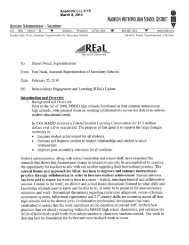
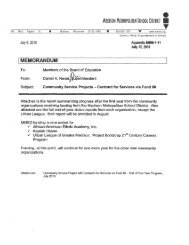
![by Shaina Wright [PDF] Ralph Waldo Emerson Prize 2006 - School ...](https://img.yumpu.com/26083584/1/174x260/by-shaina-wright-pdf-ralph-waldo-emerson-prize-2006-school-.jpg?quality=85)
